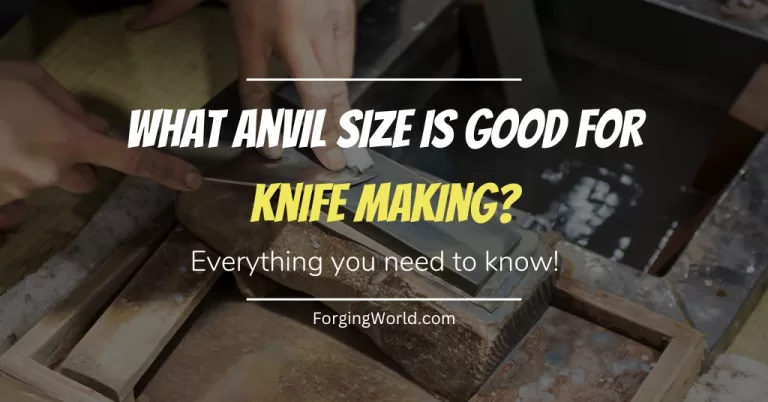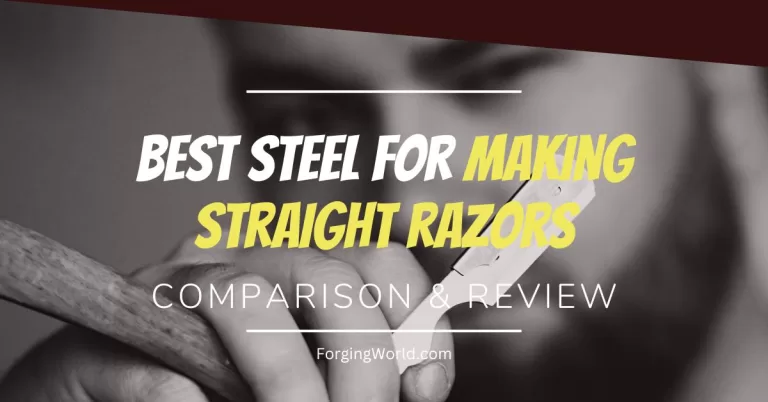When it comes to buying a knife, it’s easy to get overwhelmed by the different types and materials available.
One of the most important decisions you’ll need to make is selecting the right manufacturing process that best suits your needs.
In this blog post, we’ll be comparing three types of knives: stamped, drop forged, and forged. By the end of this article, you’ll have a better understanding of each type of knife and which one you should choose.
A Detailed Overview: Stamped, Drop-Forged, and Forged Knives
To better understand the differences between these three types of knives, let’s take a closer look at each method and the processes involved in creating them.
Stamped Knives
Stamped knives are produced by cutting the knife shape out of a flat sheet of steel, typically using a machine press. This process is known as “blanking.” After the knife blank is cut, it undergoes further processes such as:
Heat treatment: The blade is heated to a specific temperature to harden and strengthen the steel.
Grinding and sharpening: The blade is ground and sharpened to achieve the desired edge and shape.
Attaching the handle: The handle is then attached to the blade, completing the knife.
Stamped knives are popular for their lightweight, thin profile, and lower cost of production.
Drop-Forged Knives
Drop-forged knives involve heating a piece of steel and then hammering it into shape using a power hammer or a hydraulic press. The process includes:
Heating the steel: The steel is heated to a specific temperature to make it more malleable.
Forging the blade: The heated steel is placed under a power hammer or hydraulic press, which hammers it into the desired shape.
Heat treatment: Just like stamped knives, drop forged knives also undergo heat treatment for hardening and strengthening the steel.
Grinding and sharpening: The blade is then ground and sharpened to achieve the desired edge and shape.
Attaching the handle: The handle is attached to the blade to complete the knife.
Drop-forged knives are generally more durable and offer better edge retention compared to stamped knives.
Forged Knives
Forged knives are made using a similar process to drop forged knives, but the shaping of the steel is done manually instead of using a power hammer or hydraulic press. The process includes:
Heating the steel: The steel is heated to a specific temperature to make it more malleable.
Forging the blade: The heated steel is manually hammered into shape using a hammer and anvil, allowing for greater control and customization of the blade.
Heat treatment: Like the other two types, forged knives undergo heat treatment to harden and strengthen the steel.
Grinding and sharpening: The blade is ground and sharpened to achieve the desired edge and shape.
Attaching the handle: The handle is attached to the blade to complete the knife.
Forged knives are considered the highest quality among the three types due to the craftsmanship involved in their creation. They are durable, have excellent edge retention, and are often viewed as prestigious.
Now that we have a basic understanding of each technique let’s discuss the pros and cons of each method.
Stamped Knives: Pros and Cons
To help you better understand the benefits and drawbacks of stamped knives, we’ll delve deeper into each aspect, providing more context and insight.
Pros of Stamped Knives
Lightweight and Thin Profile
Stamped knives are known for their lightweight and thin profile, which can be advantageous for certain tasks that require precision and maneuverability. This makes them popular for everyday use, especially in the kitchen.
Affordability
Since the manufacturing process for stamped knives is less labor-intensive and uses less material, they are often less expensive to produce. This translates to lower prices for consumers, making them an attractive option for those on a budget.
Faster Production
Stamped knives can be produced quickly and efficiently, making them a popular choice for mass production. This is ideal for manufacturers and consumers who require a large number of knives.
Cons of Stamped Knives
Durability Concerns
Stamped knives tend to be less durable than their forged counterparts. The stamping process doesn’t create the same level of strength and rigidity as forging, which can result in knives that are more prone to bending or breaking under stress.
Edge Retention
Due to the manufacturing process, stamped knives may not hold their edge as well as forged knives. This means that they may require more frequent sharpening, which can be time-consuming and potentially damaging to the blade if not done correctly.
Prestige Factor
Stamped knives are generally considered less prestigious than forged knives. This is mainly because they are mass-produced using machines, which some may view as a less artisanal approach. This perception, however, does not necessarily reflect the performance of the knife.
Drop Forged Knives: Pros and Cons
To help you better understand the advantages and disadvantages of drop-forged knives, let’s break down their characteristics into more detail.
Pros of Drop-Forged Knives
Durability and Strength
Drop-forged knives are generally more durable and stronger than stamped knives due to the forging process. The steel undergoes significant stress during forging, which results in a more robust and long-lasting product. The molecular structure of the steel is also refined during this process, leading to improved overall performance.
Edge Retention
The forging process helps create a more consistent and refined grain structure in the steel, which contributes to better edge retention compared to stamped knives. Drop-forged knives typically require less frequent sharpening, making them more convenient for everyday use.
Balance and Heft
Drop-forged knives often have a more substantial and balanced feel compared to stamped knives. This can provide better control and stability during cutting tasks, especially for tasks that require more force.
Cons of Drop-Forged Knives
Weight and Thickness
Due to the forging process, drop-forged knives tend to be heavier and thicker than stamped knives. This can be a disadvantage for those who prefer a lighter, more agile knife for tasks that require precision and finesse.
Cost
Drop-forged knives can be more expensive than stamped knives due to the manufacturing process. The additional steps and specialized equipment required for drop forging contribute to the higher price point.
Potential for Rust
While not specific to drop forging itself, it’s important to note that drop-forged knives made from carbon steel or other non-stainless steel materials may be susceptible to rust if not properly maintained. To prevent rusting, you can choose a drop-forged knife made from stainless steel or ensure proper care and maintenance of your knife.
Learn more about rust prevention here.
Forged Knives: Pros and Cons
Forged knives are often considered the gold standard in the world of knives. Let’s delve deeper into the pros and cons of these knives, exploring the reasons behind their popularity and some factors to consider before choosing them.
Pros of Forged Knives
Durability and Strength
Forged knives are known for their exceptional durability and strength, which can be attributed to the forging process itself. The manual hammering and shaping of the steel create a more refined grain structure, resulting in a stronger, more resilient blade.
Edge Retention
Forged knives are known for their excellent edge retention, as the forging process helps to create a harder blade. This means that they can stay sharp for longer periods, reducing the need for frequent sharpening.
Balance and Heft
The forging process often results in a bolster—a thicker part of the blade near the handle—giving the knife a better balance and heft. This can be particularly helpful for tasks that require precision and control, such as chopping and slicing.
Craftsmanship and Prestige
Forged knives are often considered works of art due to the craftsmanship involved in their creation. Each knife is unique, reflecting the skill and expertise of the blacksmith. This makes forged knives more prestigious and sought-after by collectors and enthusiasts.
Cons of Forged Knives
Weight and Thickness
One of the drawbacks of forged knives is that they can be heavier and thicker than their stamped counterparts. This may not be ideal for all users, particularly those who prefer a lightweight knife for extended use.
Cost
Due to the labor-intensive nature of the forging process, forged knives can be more expensive than stamped or drop forged knives. This may not suit all budgets, particularly for those who are just starting their knife collection or are looking for a more affordable option.
Time-Consuming Production
The process of forging a knife by hand takes longer than machine-made stamped or drop-forged knives. This can result in longer waiting times for custom orders and a limited supply of forged knives on the market.
Frequently Asked Questions
Stamped knives are cut from a flat sheet of steel, while forged knives are made by heating and hammering steel into shape. Forged knives generally offer better durability and edge retention but can be more expensive and heavier than stamped knives.
In general, drop-forged knives are more durable and offer better edge retention compared to stamped knives. However, they can be heavier and more expensive. Your choice will depend on your preferences and intended use.
Yes, you can make a knife from a file or a drill bit, as they’re typically made from high-quality steel. To learn more, check out these articles on making a knife from a file and using drill bits to make knives.
Some essential tools for knife making include a forge or heat source, an anvil, hammers, tongs, a grinder, and various files.
You can find recommendations for the best gas forges, best anvils, and best hammers on our website.
The choice of quenching oil depends on your specific needs and the type of steel you’re using. Some popular options include vegetable oil, motor oil, and commercial quenching oils.
You can find more information on the best quenching oils on our website.
Final Thoughts
When it comes to choosing the right type of knife for your needs, it’s essential to understand the differences and benefits of each method.
Here’s a quick overview of the main differences and benefits of stamped, drop-forged, and forged knives:
| Feature | Stamped Knives | Drop Forged Knives | Forged Knives |
|---|---|---|---|
| Durability | Less durable | More durable | Most durable |
| Edge Retention | Lower | Better | Best |
| Weight | Lightweight | Heavier | Heaviest |
| Thickness | Thin | Thicker | Thickest |
| Balance | Good | Better | Best |
| Production Time | Fastest | Moderate | Longest |
| Cost | Least expensive | Moderately expensive | Most expensive |
| Prestige | Lower | Moderate | Highest |
| Ideal Uses | General-purpose knives | Heavy-duty knives | High-quality knives |
Stamped Knives: These knives are typically less durable and have lower edge retention compared to drop forged and forged knives. However, they are lightweight, thin, and affordable, making them ideal for general-purpose use.
Drop Forged Knives: These knives are more durable than stamped knives, have better edge retention, and are better suited for heavy-duty use. They may be heavier and more expensive, but they offer a good balance of performance and affordability.
Forged Knives: These knives are the most durable and have the best edge retention, thanks to the manual hammering and shaping of the steel. They can be heavier and thicker than stamped and drop forged knives, but they offer excellent balance, prestige, and craftsmanship.
Ultimately, the choice of knife will depend on your needs, preferences, and budget. Whether you’re a beginner blacksmith or a seasoned knife maker, understanding the differences between stamped, drop forged, and forged knives will help you make an informed decision and produce high-quality knives that meet your needs.


